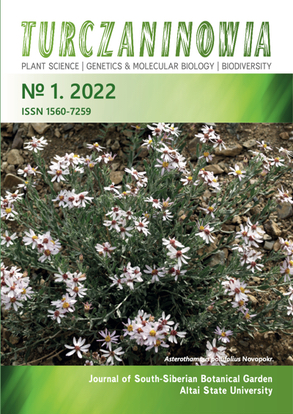To the knowledge of xerophytic floras of the Earth
Abstract
A review of both classes of flowering plants in the system of A. L. Takhtajan (1987) showed a general picture of the distribution of xerophytic phyla and groups in the Earth floras. The xerophilic lines of development in flowering plants are very ancient, and there are more of them among dicots than monocots. Xerophytic groups are more diverse in the floras of the Southern (compared to the Northern) Hemisphere, where the main centers of development of xerophilic floras are in South America, South Africa, and Australia. At the same time, New World xerophilic floras differ from Old World ones in the presence of a larger number of endemic families. The xerophytic centers of the Northern Hemisphere are in the tropics and subtropics, both in the Old and New Worlds: Africa, Arabia, India, the Mediterranean, North America (Madrean sub-kingdom).
Downloads
Metrics
References
Engler A. 1914. Üeber Herkunft, Alter und Verbreitung extremer xerothermier Pflanzen. Sitzungsber. Koenig. Preuss. Akad. Wissensch. 20: 564–621.
Ильин М. М. К происхождению пустынь Средней Азии // Сов. бот., 1937. Т. 6. С. 95–109.
Ильин М. М. Некоторые итоги изучения пустынь Средней Азии // Материалы по истории флоры и растительности СССР, 1946. Вып. 2. С. 197–253.
Ильин М. М. Флоры литоралей и пустынь в их взаимосвязях // Сов. бот., 1947. Т. 15, № 5. С. 249–267.
Ильин М. М. Флора пустынь Центральной Азии, ее происхождение и этапы развития // Материалы по истории флоры и растительности СССР, 1958. Вып. 3. С. 129–229.
Камелин Р. В. Флора Земли: флористическое районирование суши. Барнаул: ООО «Пять плюс», 2017. 130 с.
Криштофович А. Н. Происхождение ксерофитных растительных формаций в свете палеоботаники // Пустыни СССР и их освоение. Вып. 2. М.; Л.: Изд-во АН СССР, 1954. С. 583–596.
Лавренко Е. М. Основные черты ботанической географии пустынь Евразии и Северной Африки. М.; Л.: изд-во АН СССР, 1962. 169 с.
Попов М. Г. Флора пестроцветных толщ (краснопесчаниковых низкогорий) Бухары (фрагмент к истории флоры Туркестана) // Тр. Туркестан. науч. общ-ва, 1923. № 1. C. 27–64.
Попов М. Г. Основные черты истории развития флоры Средней Азии // Бюл. Среднеазиатского гос. ун-та, 1927. Т. 15. С. 239–292.
Stebbins G. L., Major J. 1965. Endemism and Speciation in California Flora. Ecological Monographs 35: 1–35. DOI: 10.2307/1942216
Тахтаджян А. Л. Система и филогения цветковых растений. М.; Л.: Наука, 1966. 611 с.
Тахтаджян А. Л. Система магнолифитов. Л.: Наука, 1987. 439 с.
Turczaninowia is a golden publisher, as we allow self-archiving, but most importantly we are fully transparent about your rights.
Authors may present and discuss their findings ahead of publication: at biological or scientific conferences, on preprint servers, in public databases, and in blogs, wikis, tweets, and other informal communication channels.
Turczaninowia allows authors to deposit manuscripts (currently under review or those for intended submission to Turczaninowia) in non-commercial, pre-print servers such as ArXiv.
Authors who publish with this journal agree to the following terms:
- Authors retain copyright and grant the journal right of first publication with the work simultaneously licensed under a Creative Commons Attribution License that allows others to share the work with an acknowledgement of the work's authorship and initial publication in this journal.
- Authors are able to enter into separate, additional contractual arrangements for the non-exclusive distribution of the journal's published version of the work (e.g., post it to an institutional repository or publish it in a book), with an acknowledgement of its initial publication in this journal.
- Authors are permitted and encouraged to post their work online (e.g., in institutional repositories or on their website) prior to and during the submission process, as it can lead to productive exchanges, as well as earlier and greater citation of published work (See The Effect of Open Access).









